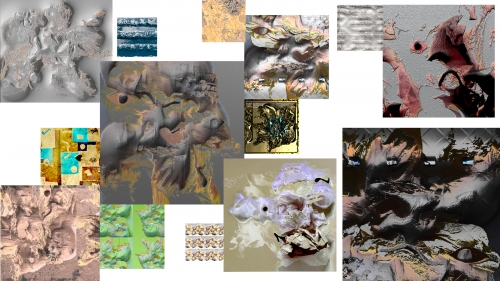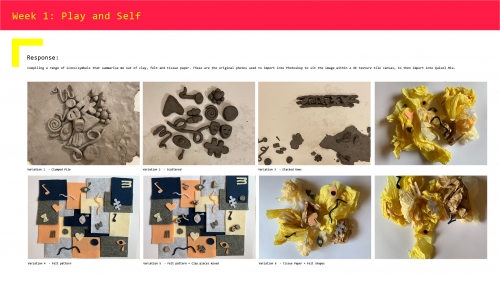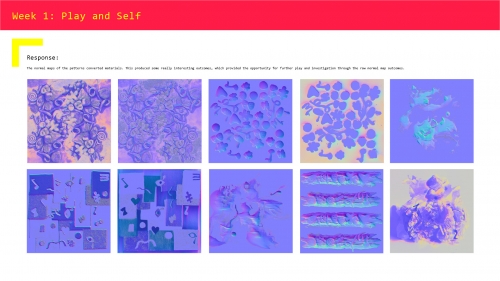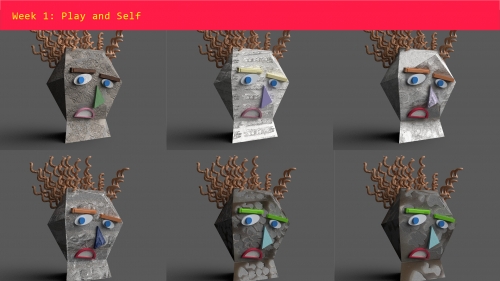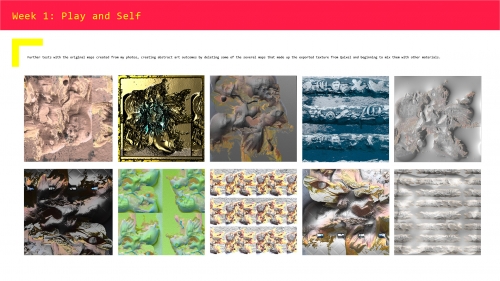
Theme:
Play and Self
Method:
Inspired by traditional methods of making art and communication, I will play with testing unconventional methods of texture generation in order to create unique patterns and textures.
Context:
This week, Matt asked us to observe ourselves in interesting ways and explore the theory of playful portraiture. This got me thinking about how I feel others so often perceive me, whilst considering my own feelings and responses around those perceptions. We have many layers to our being, in which so often, I feel as though I am some sort of foreign language to society. Leveraging this persepctive of myself, I began to think about semiotics through language and design and how this is applied through so many different ways of applying of signs, symbols and their interpretations. Egyptian hieroglyphics created a language entirely made up through a world of pictorial code and now in a digital world we ensure to match between system and the real world in order to speak the user’s language (Nielsen). The idea of exploring language through a visual approach, led me to thinking about my practice and asking how I could essentially create my own visual code that reflected me, through play with materials.
This project and testing ground sits in the field of texturing and playing with real world materials in order to explore and combine the world of both physical and digital spaces to create abstract textures, through the formation of my own coded language. Megascans are high-resolution scans of real world things that are then used to create ultra-realistic imagery in films and games. Their purpose is for realistic outcomes and providing a library of real world sources to apply to our work.
I was intruiged by the idea of testing the method of the megascan creations and how one would normally approach this, by taking a photo of the different physical materials that are a form of play and art in themselves to then take a photo of and import into a megascanning program (Quixel Mix), to then see how converting an image of something more abstract could be used to create interesting outcomes and crafting these into a series of texture maps to generate interesting aesthetic effects from each photo. Aiming to create a series of different coded textures or patterns. What that ‘coded language’ looks like as a result of play was to be determined.
Response:
- Create some personalised symbols using craft materials such as clay, tissue paper, felt
- Take a photo of each variation of play with materials
- Import into Photoshop and set the images within a 4k texture space ready for conversion
- Import photos into computer and begin applying to each texture map layer in Quixel Mix
- Export Maps
- Import into a texturing program and explore/play with illusions and blending of materials
- Setting different texture maps created to a typesetting template to create a font
- Convert into a font
Reflection:
This weeks response challenged my standard ways and habits of being a designer and initially had me falling into this trap of needing to reflect the theme in a literal sense through the form of a portrait and the need to still present something in a nice way, even if the results weren’t polished. I did set out on purpose to create symbols that reflected who I was in a literal visual sense, in order to explore the idea around semiotics and language as I felt once I started converting these handmade symbols from play, into a digital world there would be an extra level of interpretation throughout the different layers formed. So although they started out clear and simple in the start - they would grow and develop into something more curious and imaginative. Having never setup textures from scratch before, nor ever using a program typically used for mega scans, there were numerous ways in which I explored this idea of ‘play’ throughout this weeks theme. I played with real world crafting materials in order to create the symbolic language, there was play through tinkering with new software and experimenting with how I could use it whether it be in order to create the textures or create a font in the end. Play through the method itself by using more abstract imagery/art to convert into textures - rather than realistic environments and props and then play through horseing around with the textures themselves after the conversion process and testing what kind of different results I could get from these textures.
After feedback from Matt and being challenged around the 'play' and to really think about what I was testing and playing with. I decided to completely scrap my 3D head in order to feel more free through the exploration and play. I had realised, although I was testing methods it was still a little structured and anticipated through giving myself a base head to apply the outcomes to, which as noted through the feedback wasn’t really necessary. This was very much a safety net and familiar zone, in which my mind felt the need to “display” it on theme to the weekly task. As a result - the individual results weren’t pushed far enough initially and they were all looking the same, which isn’t what I was really hoping to achieve. It was true that the initial results ‘lost’ something that was within the photographs of the raw materials, however this was also part of this method and testing approach knowing they would most certainly adapt differently on screen and create completely new forms once I fooled around with the different texture maps that make up a material. I did however believe they could be pushed a lot further in order to evoke a sense of mystery and curiosity.
It actually really stumped me though in moving forward as I wasn’t sure how I was going to keep pushing this idea of play. I think the base model actually stifled my creativity in exploring the texture maps themselves, by putting a roadblock in front of me, in which I felt I could be exploring materials further with how I was mixing them in order to create different aesthetics. Before continuing, I found a book by Gordon M. Burghardt called “The Genesis of Animal Play: Testing the limits” to try and spark this idea of play a little more and was reminded of a couple of things.
- Play underlies all creativity and innovation, including art and science produced by adults
- Play is freedom
- Play activities can be nonliteral
- Play is free from the rules imposed from the outside and the rules that do exist can be modified by the players.
- Play requires the active engagement of the players.
It is a weird feeling to play freely without any end goal in site and not knowing where the tests will lead. I had a theme to leverage from in terms exploring the idea of language and an idea around testing a method, but there was no clear pathway as to what would come out of it. Which felt stressful - however in the same breathe it offered more freedom to not care too much about that ‘finalised’ result that is wired into my thinking and I began to just focus on playing with the textures using this unconventional approach. I felt once I scrapped the need to think literal and too overly symbolic, the textures started to really take to their own unique outcomes. It was pretty surprising to see the different formations taking shape, as it wasn’t what I initially was imagining - however I can’t really describe what it was I was imagining! The amazing thing I felt that came out of playing with these further, was the abstract faces that started to appear in some of them by complete accident. They are creepy, mysterious and in their own right a piece of abstract art - reflecting this idea of playful portraiture via the means of play! With a nice little collection of different textured outcomes, I was beginning to feel as though each one was unique and represented something different whilst all holding the initial crafted symbols within them somewhere. This led me to wanting to explore them all jumbled together as if they were a language of some form and thinking back to the idea of the visual coded language.
So I decided to play a little more and make a font, which in itself was an interesting outcome. In my head I was going to create a lovely colourful language using symbols and patterns, however the font program naturally simplified the designs and converted it all to monochrome - which is not what I was expecting and yet it didn’t even twig to me (as a designer) that would need to be the case - oops.The result was kind of interesting though, more simplified language with patterns I would never be able conjur up from scratch even if I tried and it kind of reflects a more tradition form of art through lino printing. Not quite what I was after and it failed a little, but provided a different and interesting outcome.
Video of my typing using the made font here: https://www.youtube.com/watch?v=58YiJhhKD7I
Some of my tests failed along the way and in the beginning I really did think I was failing with all my textures being different yet all coming out looking the same on this head. It wasn’t till I allowed myself to actually play freely, that I feel I achieved some interesting results. Some of them still feel similar, but the abstract formations and colour are somewhat all different, in which they feel like art pieces - yet something I would never be able to re-create by hand either physically or digitally without the method approached.
References:
Burghardt, G., n.d. The Genesis of Animal Play: Testing the Limits. pp.1-21.
Scoville, P, 2021. Egyptian Hieroglyphs. [online] World History Encyclopedia. Available at: <https://www.ancient.eu/Egyptian_Hieroglyphs/> [Accessed 3 March 2021].
Lidwell, W., Butler, J. and Holden, K., 2003. Universal principles of design. Gloucester, Mass.: Rockport.
Nielsen, J., 2020. 10 Usability Heuristics for User Interface Design. [online] Nielsen Norman Group. Available at: <https://www.nngroup.com/articles/ten-usability-heuristics/>.
BIDNUR, D., 2019. Early civilizations and the development of writing systems in the world. [online] Available at: <https://indusscrolls.com/early-civilizations-and-the-development-of-writing-systems-in-the-world/>.
About This Work
By Amber Stacey
Email Amber Stacey
Published On: 10/03/2021
